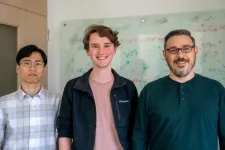(Press-News.org) Recent advances in generative AI help to explain how memories enable us to learn about the world, re-live old experiences and construct totally new experiences for imagination and planning, according to a new study by UCL researchers.
The study, published in Nature Human Behaviour and funded by Wellcome, uses an AI computational model – known as a generative neural network - to simulate how neural networks in the brain learn from and remember a series of events (each one represented by a simple scene).
The model featured networks representing the hippocampus and neocortex, to investigate how they interact. Both parts of the brain are known to work together during memory, imagination and planning.
Lead author, PhD student Eleanor Spens (UCL Institute of Cognitive Neuroscience), said: “Recent advances in the generative networks used in AI show how information can be extracted from experience so that we can both recollect a specific experience and also flexibly imagine what new experiences might be like.
“We think of remembering as imagining the past based on concepts, combining some stored details with our expectations about what might have happened.”
Humans need to make predictions to survive (e.g. to avoid danger or to find food), and the AI networks suggest how, when we replay memories while resting, it helps our brains pick up on patterns from past experiences that can be used to make these predictions.
Researchers played 10,000 images of simple scenes to the model. The hippocampal network rapidly encoded each scene as it was experienced. It then replayed the scenes over and over again to train the generative neural network in the neocortex.
The neocortical network learned to pass the activity of the thousands of input neurons (neurons that receive visual information) representing each scene through smaller intermediate layers of neurons (the smallest containing only 20 neurons), to recreate the scenes as patterns of activity in its thousands of output neurons (neurons that predict the visual information).
This caused the neocortical network to learn highly efficient “conceptual” representations of the scenes that capture their meaning (e.g. the arrangements of walls and objects) - allowing both the recreation of old scenes and the generation of completely new ones.
Consequently, the hippocampus was able to encode the meaning of new scenes presented to it, rather than having to encode every single detail, enabling it to focus resources on encoding unique features that the neocortex couldn’t reproduce – such as new types of objects.
The model explains how the neocortex slowly acquires conceptual knowledge and how, together with the hippocampus, this allows us to “re-experience” events by reconstructing them in our minds.
The model also explains how new events can be generated during imagination and planning for the future, and why existing memories often contain “gist-like” distortions - in which unique features are generalised and remembered as more like the features in previous events.
Senior author, Professor Neil Burgess (UCL Institute of Cognitive Neuroscience and UCL Queen Square Institute of Neurology), explained: “The way that memories are re-constructed, rather than being veridical records of the past, shows us how the meaning or gist of an experience is recombined with unique details, and how this can result in biases in how we remember things.”
END
Generative AI helps to explain human memory and imagination
Peer reviewed | Computational study
2024-01-19
ELSE PRESS RELEASES FROM THIS DATE:
KIST's 'Moonwalk', a robot that makes climbing Bukhansan Mountain easier
2024-01-19
As people age, they gradually lose muscle strength in their arms and legs, making it difficult for them to participate in leisure activities such as hiking and traveling, and they often need to rely on assistive devices such as canes and wheelchairs for mobility. However, these assistive devices do not improve muscle strength, so wearable robots that can compensate for the lack of muscle strength with the help of robots are attracting attention as an innovative technology to improve the health and quality of life of the elderly.
Dr. Lee Jongwon of the Intelligent Robotics Research Center at the Korea Institute of Science and Technology(KIST) ...
New air purifier design with innovative foam technology promises virus-stopping performance and zero waste
2024-01-19
Researchers at the University of Bath have invented a new form of high-performance air purifier that promises zero harmful waste.
Key to the purifier and how it works is FOAM3R filter technology, patented by the University, which is described as a highly adaptable disruptor technology for microbial, CO2 and volatile organic compound (VOC) odour removal.
FOAM3R can be used to produce multi-functional foam structures for a wide range of applications, including aircraft cabins, in-car air filters, ship and boat cabins, residential heating, ventilation and air-conditioning, home air purifiers and respirator and breathing apparatus.
The ...
Survey offers insights on childlessness and childcare in the UK
2024-01-19
Young people are increasingly planning to not have children
Millennials with stronger environmental concerns are less likely to intend to have a child, but this isn’t the case for Gen Z
Lower-income families spend more of their income on childcare than wealthier households
Parents pay an average of £560 a month on childcare – with a quarter paying over £800
A comprehensive new survey reveals the changing face of UK families amid recent economic, social, and political turmoil.
The methodology and initial findings from the UK Generations and Gender Survey are being presented today [Friday 19th January] ...
New study is one of first to show people with evidence of any remission of diabetes from weight-loss trial had a 40% lower rate of cardiovascular disease and 33% lower rate of chronic kidney disease
2024-01-19
While several trials have shown that substantial weight loss using diet and lifestyle can reverse type 2 diabetes, new research published in Diabetologia (the journal of the European Association of the Study of Diabetes [EASD]) is among the first to show the subsequent impact of remission on cardiovascular outcomes. The study is by Professor Edward Gregg, Head of the School of Population Health, RCSI University of Medicine and Health Sciences, Dublin, Ireland, and colleagues.
The new study shows that in patients that took part in the Look ...
RCSI research shows new benefits of weight loss for type 2 diabetes
2024-01-19
18 January 2024: Researchers in the School of Population Health at RCSI University of Medicine and Health Sciences have provided new evidence of the health benefits of weight loss efforts that lead to diabetes remission for type 2 diabetes patients.
For participants in the weight-loss trial who were able to achieve remission i.e. reduce the need for medications and reduce their HbA1c levels (a measure of blood sugar control), the research found there was a 40% lower rate of cardiovascular disease and 33% lower rate of chronic kidney disease in this group.
While previous trials have shown that substantial weight loss using diet and lifestyle can reverse type ...
Rice research opens new arena to study quantum interactions
2024-01-18
HOUSTON – (Jan. 18, 2024) – Quantum technologies bring the promise of faster computing, enhanced drug development and new sensing applications. However, quantum behaviors are difficult to study experimentally since most systems can only sustain quantum effects for a short time.
“The reason why quantum physics’ mysterious features tend to vanish so quickly is a process called decoherence,” said Kaden Hazzard, associate professor of physics and astronomy at Rice University and a corresponding author on a study published in Nature Physics. “It occurs when a quantum system ...
For this beetle, ‘date night’ comes every other day
2024-01-18
Life on Earth runs on a 24-hour cycle as the planet turns. Animals and plants have built-in circadian clocks that synchronize metabolism and behavior to this daily cycle. But one beetle is out of sync with the rest of nature.
A new study, published Jan. 18 in Current Biology, looks at a beetle with a unique, 48-hour cycle. The large black chafer beetle, Holotrichia parallela, is an agricultural pest in Asia. Every other night, the female beetles emerge from the soil, climb up a host plant ...
National Science Foundation taps NYU Tandon with $5 million grant to advance accessibility
2024-01-18
A team at NYU Tandon School of Engineering will kick off the second phase of an ambitious research project that aims to transform navigation and accessibility for many of the 285 million people with blindness and low vision (pBLV) worldwide.
The National Science Foundation (NSF) awarded the project a three-year $5 million grant last month.
Led by John-Ross Rizzo – an associate professor in NYU Tandon’s Biomedical Engineering department, associate director of NYU WIRELESS, affiliated faculty at the NYU Tandon Center for Urban Science and Progress (CUSP) and associate professor in the Department of Rehabilitation Medicine at NYU ...
Texas A&M AgriLife Research study may lead to novel obesity treatment
2024-01-18
MEDIA INQUIRES
WRITTEN BY
Laura Muntean
Paul Schattenberg
laura.muntean@ag.tamu.edu
paschattenberg@ag.tamu.edu
601-248-1891
210-859-5752
FOR ...
Semen microbiome health may impact male fertility
2024-01-18
You may have heard about the gut microbiome and its influence on a person’s overall health and well-being. It turns out that the same may hold true for the semen microbiome.
According to researchers from the Department of Urology at UCLA, the semen microbiota might play a crucial role in influencing sperm parameters and enhancing male fertility. Considering recent studies highlighting the microbiome’s significance in overall human health, researchers investigated the semen microbiome to understand its potential impact on male infertility. Exploring the functions of these microorganisms in semen could potentially pave the way for developing treatments targeted ...
LAST 30 PRESS RELEASES:
Heart-brain connection: international study reveals the role of the vagus nerve in keeping the heart young
Researchers identify Rb1 as a predictive biomarker for a new therapeutic strategy in some breast cancers
Survey reveals ethical gaps slowing AI adoption in pediatric surgery
Stimulant ADHD medications work differently than thought
AI overestimates how smart people are, according to HSE economists
HSE researchers create genome-wide map of quadruplexes
Scientists boost cell "powerhouses" to burn more calories
Automatic label checking: The missing step in making reliable medical AI
Low daily alcohol intake linked to 50% heightened mouth cancer risk in India
American Meteorological Society announces Rick Spinrad as 2026 President-Elect
Biomass-based carbon capture spotlighted in newly released global climate webinar recording
Illuminating invisible nano pollutants: advanced bioimaging tracks the full journey of emerging nanoscale contaminants in living systems
How does age affect recovery from spinal cord injury?
Novel AI tool offers prognosis for patients with head and neck cancer
Fathers’ microplastic exposure tied to their children’s metabolic problems
Research validates laboratory model for studying high-grade serous ovarian cancer
SIR 2026 delivers transformative breakthroughs in minimally invasive medicine to improve patient care
Stem Cell Reports most downloaded papers of 2025 highlight the breadth and impact of stem cell research
Oxford-led study estimates NHS spends around 3% of its primary and secondary care budget on the health impacts of heat and cold in England
A researcher’s long quest leads to a smart composite breakthrough
Urban wild bees act as “microbial sensors” of city health.
New study finds where you live affects recovery after a hip fracture
Forecasting the impact of fully automated vehicle adoption on US road traffic injuries
Alcohol-related hospitalizations from 2016 to 2022
Semaglutide and hospitalizations in patients with obesity and established cardiovascular disease
Researchers ‘listen in’ to embryo-mother interactions during implantation using a culture system replicating the womb lining
How changing your diet could help save the world
How to make AI truly scalable and reliable for real-time traffic assignment?
Beyond fragmented markets: A new framework for efficient and stable ride-pooling
Can shape priors make road perception more reliable for autonomous driving?
[Press-News.org] Generative AI helps to explain human memory and imaginationPeer reviewed | Computational study




